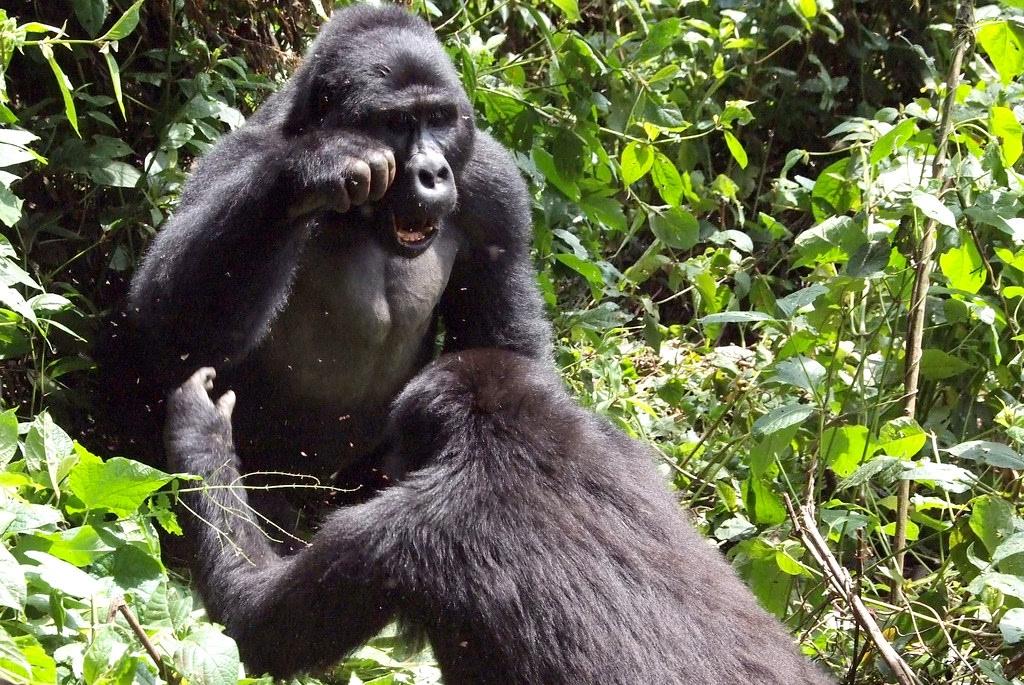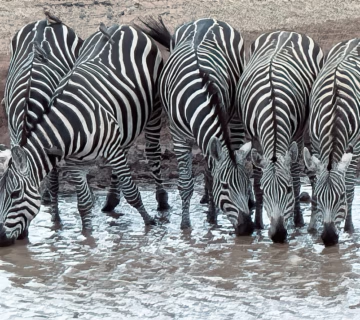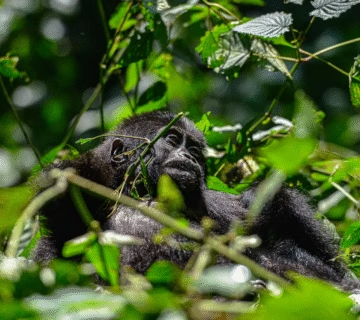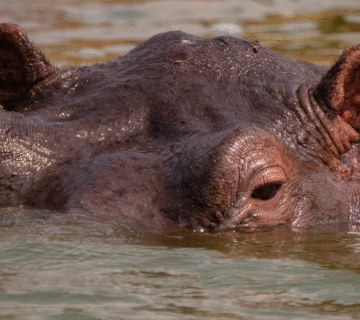Where to go for mountain gorilla trekking in Africa
Where to go for mountain gorilla trekking in Africa: With over 1,000 mountain gorillas still living on the planet. Mountain gorillas are one of the world’s most intelligent creatures. An encounter with these great gentle primates is considered one of the best adventurous activity experiences because they look and organize themselves like humans. Mountain gorillas are among the four types of gorillas in Africa, including eastern lowland gorillas (Grauer’s gorillas), cross-river gorillas, and western lowland gorillas. Mountain gorillas are found in only three countries in central Africa, such as Uganda, Rwanda, and the
Democratic Republic of the Congo, with Uganda hosting the highest number of these fascinating mountain gorillas that can be seen in two national parks, including the Mgahinga gorilla national park and the Bwindi impenetrable forest national park. In Rwanda, these fascinating caves can be found in the Volcanoes National Park, while in the Democratic Republic of the Congo, they are in the Virunga National Park. They’re one of the biggest and most powerful living primates, with an average silverback gorilla that can weigh up to 180kg (that’s almost 30 stone) and measure 170cm tall on all fours.
In contrast, female mountain gorillas weigh 90kg and measure up to 150cm. Mountain gorillas spend about a quarter of their day eating, mainly plants. Around 85% of their diet is made up of leaves, shoots, and stems, but gorillas can also eat larvae, snails, ants, and even roots, bark, and rotting wood. Most mountain gorillas live in stable family groups of around 10 individuals, with one dominant male and several females. Both males and females in the group care for their infants, hugging, carrying, and playing with them.
At night, mountain gorilla groups sleep together in nests on the ground or in trees that they make from foliage. Infants will share their mother’s nests, staying safe and warm. The main threat to mountain gorillas is the degradation of their habitat. As the region’s population grows, the land is increasingly converted for agriculture, and competition for limited natural resources leads to deforestation. With little other choice, people enter mountain gorilla forests to collect water and firewood, putting gorillas at risk of human contact and illnesses.

People may also lay snares intended for bushmeat, which can accidentally injure the great primates. Gorillas don’t just stay in their forests. They venture onto farmland to eat crops like maize and bananas, which can cause conflict with people who need to make a living. Where to go for mountain gorilla trekking in Africa: Gorilla trekking in Uganda Gorilla trekking in Uganda offers a remarkable opportunity to observe these incredible creatures in their natural habitat.
Uganda is home to two main destinations where this fascinating and captivating primates area these national parks include Bwindi Impermeable Forest National Park and Mgahinga Gorilla National Park with Bwindi Impenetrable National Park known for hosting a large population of mountain gorillas with over 25 habituated gorilla families such as Mubare gorilla family, Habinyanja gorilla family, Rushegura gorilla family, Rushegura gorilla family, Rushaga Sector Groups, Bweza gorilla family, Nshongi Gorilla Family, Nkuringo Gorilla Family, Oruzogo Gorilla Family, Bitukura Gorilla Family among others whereas Mgahinga National Park offers amazing gorilla trekking opportunities but has a smaller gorilla population concentrating in one gorilla family famously known as Nyakagezi Group.
Where to go for mountain gorilla trekking in Africa Gorilla trekking in Bwindi Impenetrable National Park Where to go for mountain gorilla trekking in Africa: Gorilla trekking in Rwanda Mountain gorilla trekking in Rwanda is only done in the Volcanoes National Park, which covers an area of 160 sq km of rainforest and comprises five of the eight volcanoes in the Virunga Mountains, such as Sabyinyo, Gahinga, Muhabura, Bisoke, and Karisimbi. The park is the home of the two largest remaining populations of mountain gorillas from over 11 habituated gorilla families, such as Karisimbi, Amahora, Susa A, Umubano, Kirwa, Kwitonda, Bwenge, Ugenda Titua Agashya, and Sabyinyo groups.
This magnificent creature thrives in its natural habitat within the Rwanda Park of the Virunga Mountains, a range of six extinct and three active volcanoes that also extend to Uganda and the Democratic Republic of the Congo. Where to go for mountain gorilla trekking in Africa: Gorilla trekking in the democratic republic of Congo Mountain gorilla trekking in the Democratic Republic of the Congo is only carried out in the Virunga National Park. Virunga National Park is the world’s second-largest tropical rainforest and is well known as the park of fire and ice for its diverse inhabitants.
The park is home to the third of the remaining world’s largest mountain gorillas, and its home to over 300 individuals of the 1000 mountain gorillas in the wild, residing in eight habituated mountain gorilla families such as the Kabirizi gorilla family, the Nyakamwe gorilla family, the Lulengo gorilla family, the Mapuwa gorilla family, the Humba gorilla family, the Bageni gorilla family, and the Rugendo gorilla family. The park is home to two of the eight active volcanoes in the Virunga conservation region, but surprisingly, the park holds the largest world-lave Crater Lake, situated at the summit of Mount Nyiragongo.
However, gorilla trekking safaris in Rwanda can be conducted in Volcano National Park. Gorilla trekking experiences Trekking gorillas in both mountain gorilla destinations contain magical surprises. Gorilla trekking involves walking in the jungles of the tropical rainforest to hunt for these magnificent mountain gorillas since national parks are situated in the lush vegetation of the rainforest and lean on the same guiding rules, regulations, and expectations while on gorilla trekking safaris. Gorilla trekking safaris all begin in the morning with brief guidance and regulations, as well as expectations while in the forest.
Trekking these fascinating primates is only allowed to persons over the age of 15 years, with a maximum number of 8 in each gorilla group, where they will be allocated to a specific habituated gorilla group. Gorilla trekking in both national parks involves walking on foot in the jungles of the tropical rainforest in search of mountain gorillas in their respective families, and trekking these fascinating primates takes 4-6 hours depending on where the gorillas have spent their nights. While on the trek, tourists will also get to meet with other wild animals and become fascinated. Upon encountering these magnificent creatures, visitors are always allowed one hour of interaction with the gorillas in their habituated family while keeping their eyes intact and watching how these creatures carry out their daily activities in the wild, such as playing, feeding, and breastfeeding, among others.
What are the cost differences between Rwanda, Uganda, and Congo? The gorilla trekking permit in Uganda costs $800 per person per trek for foreign non-residents, $700 per person for residents, and 300,000 UGX for East African citizens. This allows you to spend one hour encountering the mountain gorillas in their natural habitat. The gorilla trekking permit in Rwanda costs $1,500 per person per trek for foreign non-residents, $600 per person for residents, and 200,000 UGX for East African citizens. This allows you to spend one hour encountering the mountain gorillas in their natural habitat in Volcanoes National Park. A gorilla trekking permit in Congo costs $400 per person per trek for foreign non-residents, $200 for East African residents, and $20 for national citizens of Congo.



